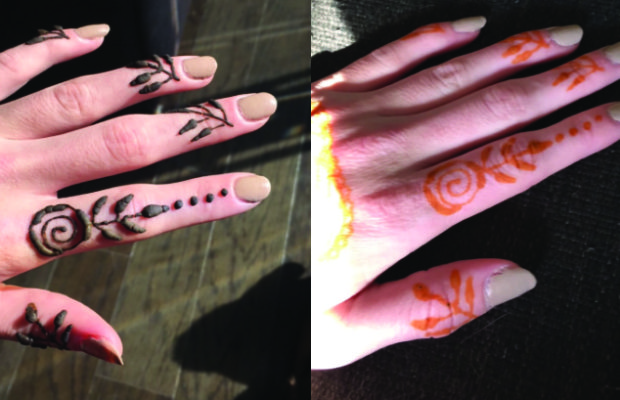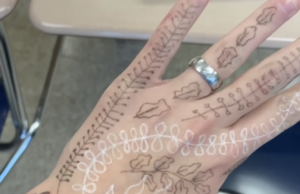Henna makes body art easily available to everyone

Henna tattoos have been around for more than 5,000 years and are still being used today to create temporary beautiful designs on your skin.
So what is henna? It is a sort of paste made from a flowering plant that grows in tropical and subtropical regions of Africa and Asia. The plant itself is called a henna tree and/or an Egyptian privet.
Henna is completely safe for your skin, but it can sometimes cause a reaction if you turn out to be allergic to it. To be safe, you should always do an allergy test before applying a large henna design to your skin.
To do said allergy test, all you have to do is make a pea-sized dot of henna on your forearm. Wipe it off and wait two-three hours to see if you experience any burning sensations or break out in a rash.
If any of these things happen wash the henna off right away. If you are not allergic to it, congratulations.
Henna tends to stay on for a week or so, but that depends on where the henna is applied and how much you apply. For example, henna will stay longer on thicker skin such as the palm of your hand.
You buy henna at any craft store. If you get it from a craft store, it will come in a powdered form which you will then have to mix with water and/or other ingredients to turn in into a paste.
If you prefer to skip the extra steps of mixing and measuring, you could order some premade henna from the Internet.
Henna comes in many colors from the regular reddish-brown color to a blinding white, but one color it will never come in is black. Beware of the black henna. While using black henna would help it look more like a real tattoo, there comes a dangerous side effect of using it.
Black henna contains paraphenylenediamine or PPD, which is a hair dye, but when applied to the skin can cause blisters, open sores, scarring and more.
If anyone offers to sell you black henna, don’t trust them because there is no such thing as black henna.
When you apply henna, it will take time to dry. It is completely fine if it ‘cracks’ while it is drying or even falls off. This is supposed to happen.
When the henna comes off it will seem pretty light and unoticable, maybe even look a strange orange, but the next day it will darken up into a nice reddish-brown color.
Now with all of that information cleared up, here are some tips and tricks for drawing henna designs.
A simple flower design:
Start out in the middle of your palm by drawings a pea sized dot in the center.
On the side of the dot, start trailing a spiral around it about three times.
End the spiral by connecting it back into another spiral line.
Create the petals of the flower by making tiny triangles (or any shape you would like) around the entire spiral.
(Optional) Add leaves by making a large triangle and slowly bring the point of the triangle inward to make it look more like a leaf.
Another flower design:
Draw a dot in the middle of your hand.
Draw a small circle around the dot and a slightly bigger circle around that circle.
Start drawing the tops of hearts, connecting the point of the hearts to the second circle.
Repeat until you have drawn them around the whole circle.
A lace-like design:
Start by drawing a line.
Make little half circles connecting to said lines until you reach the end of the line.
It will begin to look like lace.
Things to remember: Henna will go on brown (depending on what color you get), but it will come off looking orange. Don’t worry about it looking orange, for it will darken up over the next day or so.
As for designs, you can easily make up your own designs, write a quote and/or song lyrics or you can look up henna designs on google to help you think of ideas.









You must be logged in to post a comment Login